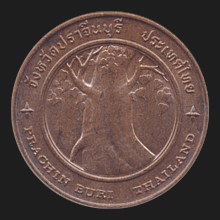|
Prachinburi (ปราจีนบุรี)
Thai.
Province (map) in East Thailand as well, as the name of its capital city, situated 135 kms East of
Bangkok.
The area of Prachinburi has been inhabited by prehistoric groups of people, long
before the
Sukhothai period, as is known from
archeological findings in the area, which includes Chinese earthenware from the
Song Dynasty, suggesting early ties with
China.
Yet, it is believed that the area has been inhabited much longer and that its
civilization probably goes back as far as Proto-history, that is 2,000-2,500
years ago. Excavated evidence in support of this include small Indo-Pacific
style glass beads, stone beads, quartz, and metal tools. It also shows an
ancient connection and relation with India. Also parts of brass
klong mahorateuk drums were found, an
ancient artifact from Dong Chon (Đông Sơn), which suggest ties with other
Southeast Asian nations. The province is today
still scattered with less important ruins from both the
Dvaravati
and
Khmer period, with the majority remaining unrestored and some sites amounting to no more than a loose collection of
laterite blocks.
The name Prachinburi first occurs only in the
Ayutthaya
Period and is a compound name, made of the words prachin (ปราจีน) or pachin (ปาจีน),
the opposite of
prajim and
meaning ‘eastern’, and
buri meaning ‘city’, which
correspondents with its location, as seen from the then capital. In the
beginning of the
Thonburi
period, general
Taksin passed through
Prachinburi on his way to
Chanthaburi,
where he led the remaining Siamese troops and (mainly Chinese) mercenaries, who
after the fall of Ayutthaya were about a thousand strong. In the
Rattanakosin period, King
Rama III had
Khlong Saen Saeb
built, a canal that connects Bangkok to Prachinburi, via the Bang Pa Kong River
in
Chachengsao, in order to
facilitate a quick route to dispatch troops and war material from the
newest capital to the eastern provinces, thus advancing
the war effort during the
Annam-Siam
War. Later, King
Rama IV
had a city fortress built, known as Pom
Meuang
Prachinburi (ป้อมเมืองปราจีนบุรี), though
its construction only finished in the reign of King
Rama V, during
whose reign the city rose in importance following the discovery of gold, found
in Kabinburi.
In the North of the province there are several waterfalls and an interesting cave. Prachinburi's
places of interest include the Prachinburi National Museum with Dvaravati artifacts
discovered in seven different provinces,
Suan Phan
Phai - a
bamboo reproduction garden with an area of about 300
rai
and a wide collection of bamboo species for research and breeding,
Khao Yai National Park
with the three level Hew
Narok waterfall of which the
first level is 60 meters high and its total height well over 100 meters,
Wat Kaew Phichit,
the King
Naresuan the Great Shrine,
etc. The province has seven
amphur. See also
Phachinburi data file.
回






|

